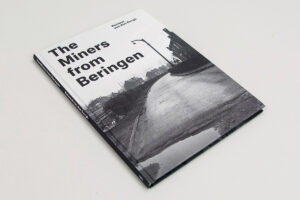YOUR CART
- No products in the cart.
Subtotal:
€ 0

SOLD OUT
Photography:
Reinout van den Bergh
Design:
Rob van Hoesel
Image processing:
Felix Bisschoff (Pixelink)
Lithography:
Marc Gijzen
Texts:
Filip Delarbre
Johanna Rediers
Leen Roels
Guido van Eijck
Reinout van den Bergh
Patrick Witters
Wiesje Peels
Translation:
Dagmar Larsen
Print:
NPN Printers (NL)
Binding:
Abbringh (NL)
Supported by:
Erfgoedcel Mijn-Erfgoed
Vrienden van het Mijnstreekmuseum vzw
Mijnmuseum vzw
Thousands of miners lived in the mine housing estate in Beringen in Belgian-Limburg. The mine permeated the estate. The word “mine” was mentioned on street nameplates, café windows and on the church wall. From the start of the 20th century, every day thousands of miners extracted coal from the ground. Daily they exchanged daylight for dark mine shafts. In their spare time they got together during sporting events and in the theatre, church, mosque and the café.
Here, Reinout van den Bergh (NL) took his photographs in 1981. With his camera he was part of the community. He joined the miners into the bathing rooms and into their homes and followed them underground. He zoomed in on their black stained faces, recorded their daily rituals and photographed the dangerous work with which they earned their bread.
For a while he lived above the Turkish café Vatan (which means “home”). During his stay he made friends for life. Reinout became intrigued by the hierarchical structure within the mining estate, as well as by the fact that life and work went hand in hand there. One of the places where the contradictions were most obvious was the main entrance of the mine: across from Café Modern and adjacent to the park where the director lived in his luxurious villa.
On the 28th of October 1989, the mine closed forever.
Reinout van den Bergh studied photography and audiovisual design at St. Joost, Breda. Since 1982, Van den Bergh has been working from Breda as a photographer and audiovisual designer. In this capacity he has travelled throughout Europe, Africa, Asia, the Middle East, the USA and Latin America. He worked for various ethnographical museums and for Dutch development cooperation. His work has been exhibited in various museums in Eastern and Western Europe and Africa, and published in several books and other publications. As of 2006, Van den Bergh has been curator of BredaPhoto. He also supervises students and graduates of its International Talent Program.